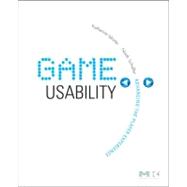
Note: Supplemental materials are not guaranteed with Rental or Used book purchases.
Purchase Benefits
Looking to rent a book? Rent Game Usability: Advancing the Player Experience [ISBN: 9780123744470] for the semester, quarter, and short term or search our site for other textbooks by Isbister; Katherine. Renting a textbook can save you up to 90% from the cost of buying.
| Bringing Usability Theory and Practice to Games | |
| Keith Steury, and/or Randy Pagulayan (Microsoft) | |
| What usability is and isn't: Usability Testing vs playtesting or QA testing Kevin Cheng (OK/Cancel) Usability vs challenge AKA Intended challenge vs unintended challenge | |
| (t.b.d.)Leveraging your audience's schemas/metaphors, and recognizing when your game does things that don't match those schemas | |
| (t.b.d.)Test early, test often (perhaps including some discussion of attention to usability in the original design | |
| This has overlap with prototyping | |
| Knowing the User | |
| User needs and motivations | |
| Nicole Lazarro (XEO design) | |
| The four fun keys (Understanding play styles and how they relate to usability of games) | |
| Katherine Isbister (RPI) | |
| Games are social (Testing with groups) | |
| Tsurumi and Hasegawa (Sony) | |
| Culture and usability (Localization and usability) | |
| (Hayan Chen is an alternative author) Debra Lieberman (UCSB) Kids and usability (Testing with children) | |
| Methods Microsoft group | |
| Case study on application of classical usability methods to games Steve Swink (Flashbang Studios) | |
| Prototyping to enable early testing Noah Schaffer(RPI) | |
| Heuristics Sauli Laitinen (Adage Corp) | |
| Expert Evaluation (e.g. Persona Walkthroughs, several experts assess an interface and you compare) | |
| Jettie Hoonhout(Philips Research) | |
| User Testing with Retrospective Think-Aloud Mie Norgard and Yanus (U. of Copenhagen) | |
| Half of your job is Politics | |
| Usability in the Trenches (could break this up: Selling usability in your company, Reporting usability problems and being heard without making enemies) | |
| Measures Regan Mandryk (U. of Saskatchewan) Combined physiological measures Hazlett and Benedik(Johns Hopkins School of Medicine, Microsoft)Muscle movement measures Peter Vorderer (formerly USC)Enjoyment measures (alternative author Wijnand Ijsselsteijn) | |
| Special Contexts Janneke Verhaegh (Eindhoven U. of Tech.) | |
| Usability in Educational Games Ermi and Mayra (U. of Tampere, Finland) | |
| Usability for Mobile Games Jane McGonigal (formerly 42 Entertainment) | |
| Usability for Ubiquitous Games | |
| Pulling it all Together Isbister and Schaffer (RPI)Recommendations for incorporating the methods discussed into the development process; pointers to further resources | |
| Key Contributors: Top of their Field: their careers and contributions | |
| Randy Pagulayan: User Research Lead, Microsoft Game Studios | |
| Most recent project has been working on Halo 3 (see September Wired article. Nicole Lazarro: CEO of XEO Design. One of the first people in the industry to systematically study the user experience of games, has consulted to most of the big game companies (e.g. Maxis, Sega, Ubisoft, Sony Online) | |
| Katherine Isbister: Frequent speaker at GDC (Game Developers Conference) on the topic of using social/emotional research to improve game design | |
| Won best of conference DVD in 2004 | |
| Wrote MK Game book on Game Character Design nominated for industry award, positively reviewed and cited, used by industry leaders | |
| Debra Lieberman: Professor at UC Santa Barbara, specializing in kids and games and other media | |
| She has worked on games for Nintendo and is a leader in the research community in bridging to industry | |
| Steve Swink: Game designer, instructor, and analyst | |
| An up-and-comer in the independent games area at GDC, who brings rigor to his prototyping and ability to dissect how what he does impacts game play | |
| Writing a forthcoming MK Game book called Game Feel | |
| Sauli Laitinen: Author of this article on Games Usability in Gamasutra | |
| One of the first articles of its kind on the topic in the games press | |
| Regan Mandryk: Currently a professor at University of Saskatc | |
| Table of Contents provided by Publisher. All Rights Reserved. |
The New copy of this book will include any supplemental materials advertised. Please check the title of the book to determine if it should include any access cards, study guides, lab manuals, CDs, etc.
The Used, Rental and eBook copies of this book are not guaranteed to include any supplemental materials. Typically, only the book itself is included. This is true even if the title states it includes any access cards, study guides, lab manuals, CDs, etc.